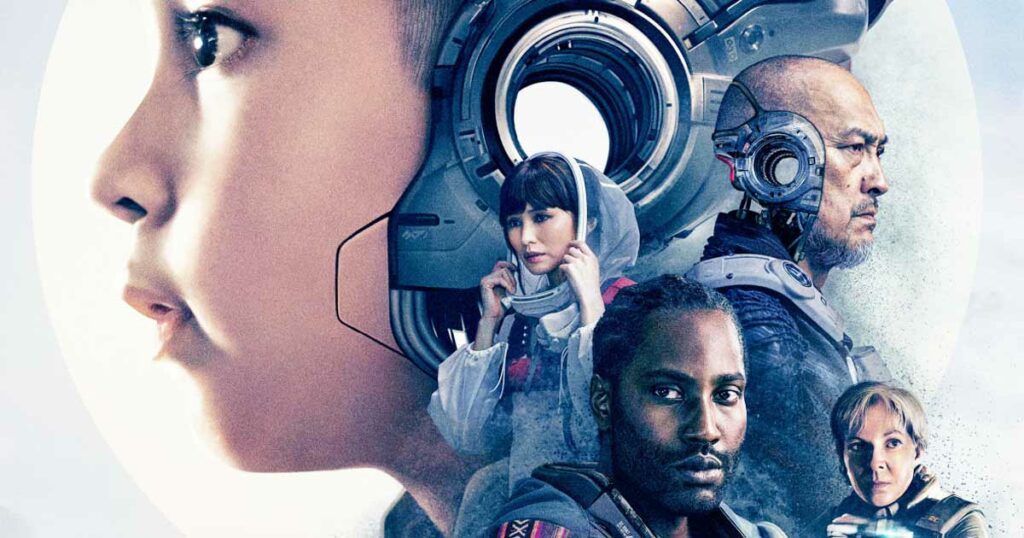Directed by Gareth Edwards | Written by Edwards and Chris Weitz | 133 min | ▲▲▲▲△
About 20 minutes into The Creator it was clear to me how this non-Intellectual Property, non-franchise, stand-alone big budget science fiction movie got green-lit: James Cameron. This is a movie that’s following Cameron’s sci-fi movie playbook — it’s deeply indebted to Avatar and The Terminator. If you’re going to produce something at this scale there needs to be a box office path to follow. It’s the one flattened by Jim.
It doesn’t take long to register other antecedents — a lot of Ridley Scott’s science fiction universes, Ex Machina in some of the character designs, Spielberg’s A.I., Akira, Scorcese’s Kundun, a couple of Neill Blomkamp’s projects — probably not what Edwards intended given the failure of Chappie to find an audience — and maybe even Edwards’ own work in Rogue One: A Star Wars Story, though I wouldn’t give him grief for borrowing from himself.
The pastiche of previous movies is obvious while the script is frequently awkward, making it hard to appreciate the elegance of the craft that’s also on display — The Creator is giving A-production value to a B-movie with a too often C script.
I’m still giving it a flattering grade because it’s easily the best looking science fiction film in yonks, maybe since Dune (also shot by DP Grieg Fraser), certainly since Blade Runner 2049, and, no surprise, the connection with those films becomes even more pronounced with composer Hans Zimmer on board. (A nod of the cap to a few terrific needle drops, like for Radiohead’s “Everything In Its Right Place.”) The Creator is so gorgeous it’s easy to forgive a lot of the derivative elements while it eventually finds a way to deliver genuine drama.
We meet Joshua (John David Washington) and his pregnant wife Maya (Gemma Chan) in a beach hut in 2065 just before American soldiers attack — Joshua’s been working undercover for the Yanks to locate the AI chief architect, named Nirmata, in New Asia. It’s a part of the world where humans and AI (mostly a lot of ambulatory robots) are friendly. The US has been at war with the AI since they launched a nuclear attack on Los Angeles some years before.
Also on the scene are simulants, AI who look like human beings but for holes through their heads — given they’re so obviously mechanical the human faces seem a strange vanity, but OK.
Maya, who is an ally of the ‘bots, is appalled when she discovers Joshua’s betrayal, but not for long — she’s killed by a missile strike by NOMAD, a floating American weapons platform. This feels like it might be a bit of a fridging, but is she actually dead? Five years later Joshua is invited back to New Asia (by a tough-as-nails colonel played by Allison Janney) as part of an American strike force aiming to find a new AI weapon designed by Nirmata that’s so advanced it could bring down NOMAD and turn the tide of the war. Joshua’s provided evidence suggesting Maya is still alive, and that’s all he cares about.
When he finds the weapon, it’s a little girl simulant, who he names Alphie (Madeleine Yuna Voyles). Convinced Alphie can lead him to Maya, they travel across the country — gorgeous locations through Thailand — while dodging AI forces and the Americans who are starting to suspect he’s switched sides.
As I said above, what makes all this watchable is the incredible scale and visuals. Even when they’re entirely derivative to Blade Runner or Akira, they’re still astonishing, from the terrifying NOMAD platform to the credible mix of futuristic design and gorgeous South Asian landscapes. The robots are also never less than impressive, though a few of them — like an ambulatory oil barrel that runs like Tom Cruise and explodes — are also ridiculous.
The script is sophisticated enough to work as an allegory of bigotry and persecution of any minority subculture — in this case those self-aware AI. It also takes shots at the American military industrial complex while slyly making China complicit with a scene of what looks like a Tibetan Buddhist sanctuary invaded by military forces — the little girl may as well be a robot Dalai Lama.
What works a whole lot less well is a script that leans too often on convenient and obvious exposition. Poor Sturgill Simpson, playing an old pal of Joshua’s, has to threaten him not to “go native,” which might be the most unnecessary line in a movie with too many of them. The great Ken Watanabe as a simulant has a few clunkers, too, but he pulls them off.
The film fails to provide enough of a backstory for Joshua and Maya to justify his obsession — dreamlike clips of the couple spinning on a beach don’t really do the trick, especially when we learn things about what Maya did while she and Joshua were a couple (and he was a spy) that seem next to impossible to have pulled off without him knowing. I mean, how long were they married? The film’s also paced at a gallop, where a few more moments to breathe might’ve opened it up a little.
But these plot and character issues do fade into the background somewhat with a third act that adds genuine suspense to the jaw-dropping visuals in a race-against-time finale. The movie provides a moment of redemption for Joshua and connects him with Alphie which, thanks especially to the impressive performance from nine-year-old Voyles, makes for welcome emotion that is missing earlier on.

















